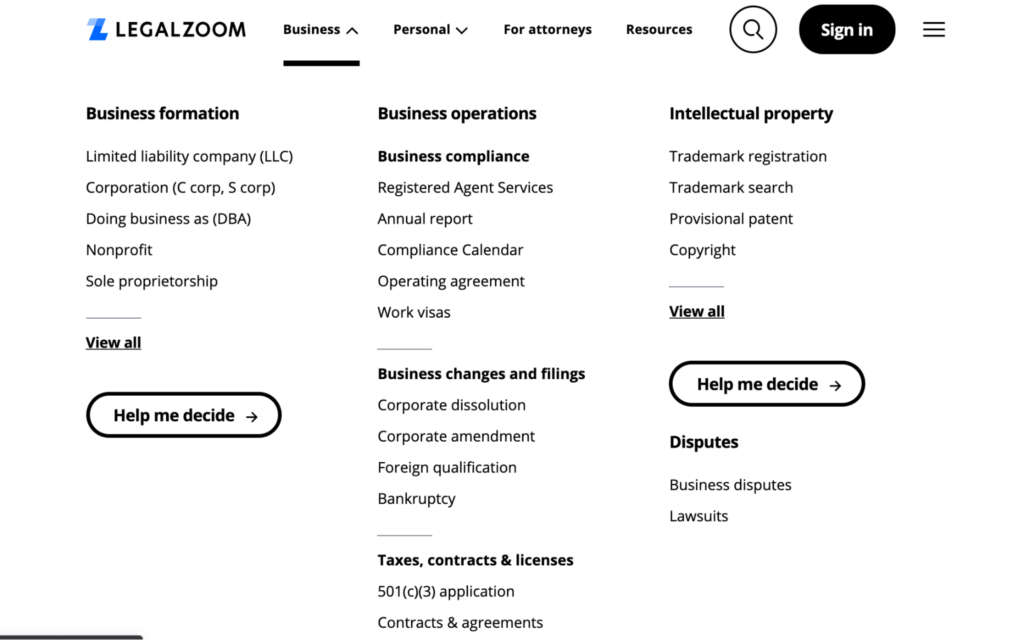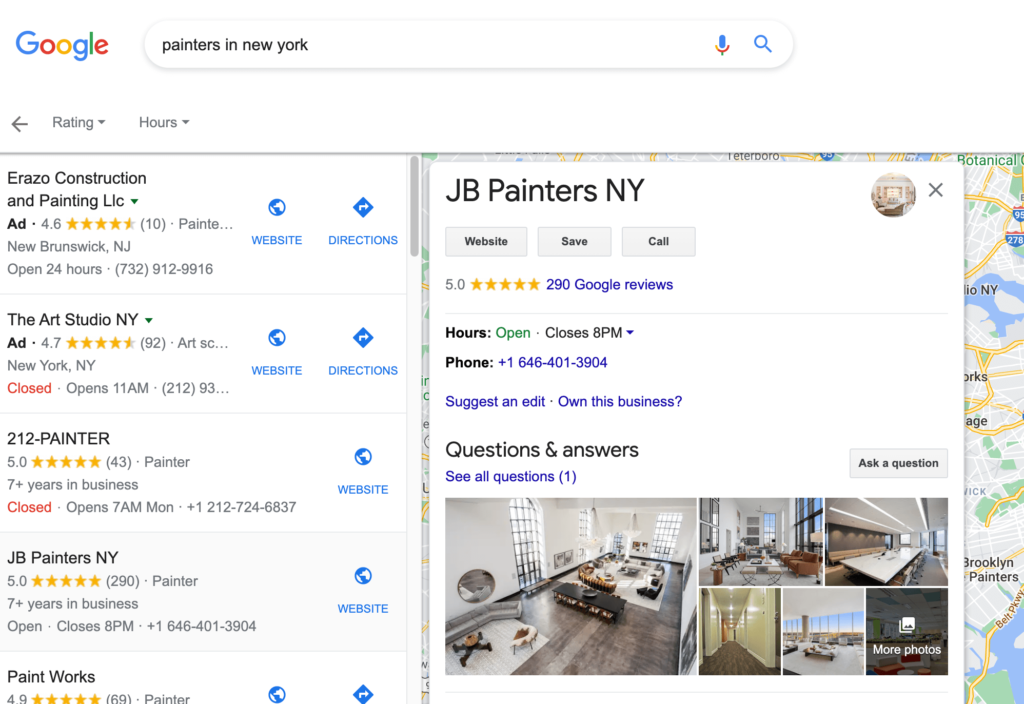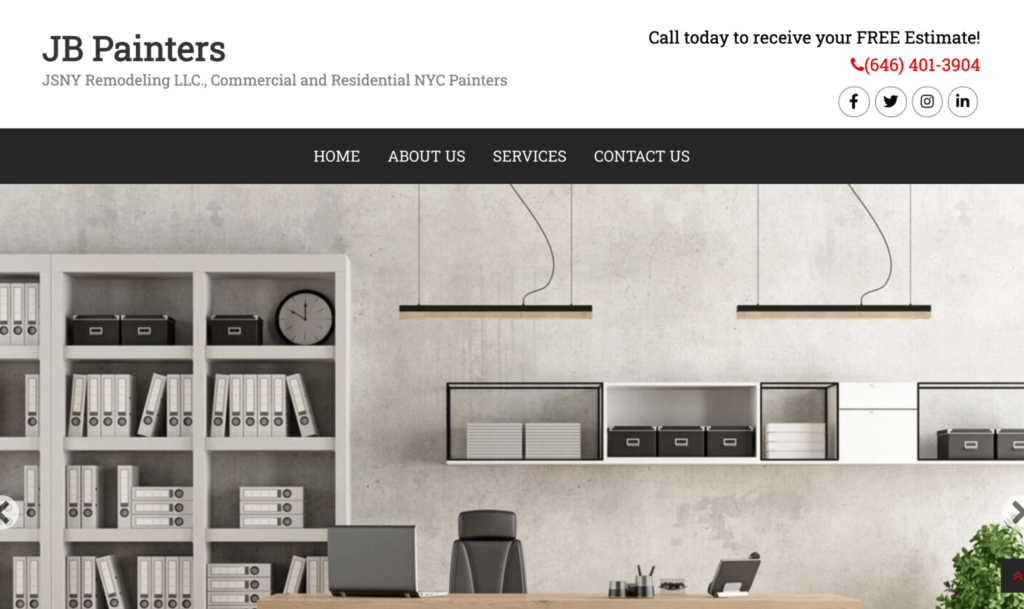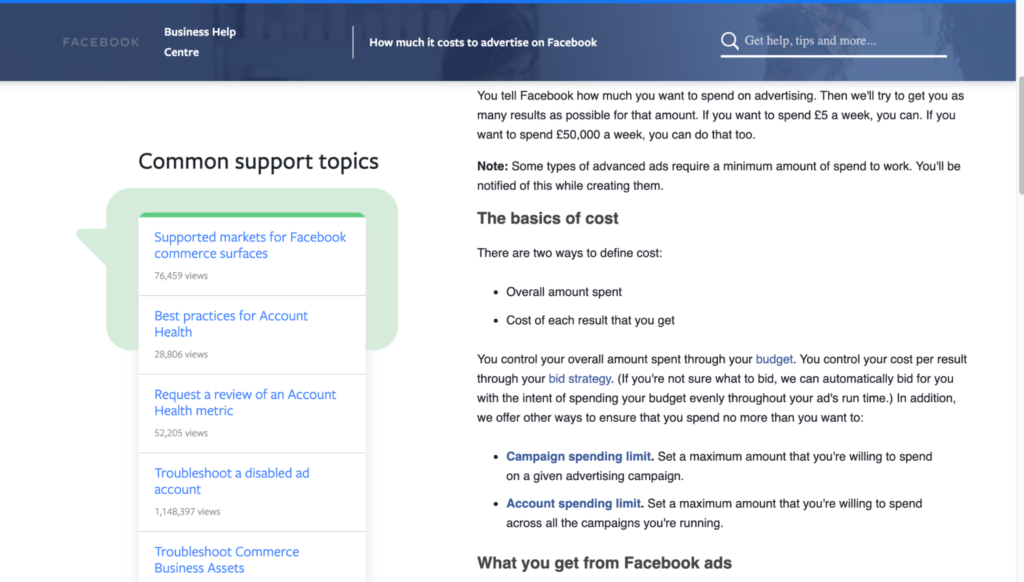As startups go, a painting business is a smart move.
There’s very little up-front investment, you don’t need extensive training or a specialized degree, and it’s always in demand.
Plus, it’s not a service that people can buy online, so there’s no chance of being undercut by Amazon.
However, many people drop the ball when marketing their services due to the high competition and low prices. Having a solid plan and online presence is essential, but not everyone knows how to set that up.
Once you learn how to find clients, though, painting is an easy, relatively low-stress way to make consistent money and become financially independent.
The Easy Parts of Starting a Painting Business
One of the easiest things about starting a painting business is that anyone can do it with a bit of organization. There’s no need to have a degree or get a license–you don’t even have to be particularly artistic or creative.
And even setting up the legal aspects of the business is easy, thanks to automation and business formation services. Formation services can help you navigate the state requirements for taxes, registering your business, and even creating a business plan.
One of the most popular business formation services is LegalZoom, which offers packages and services covering almost every legal aspect of launching a business. They can help you get the correct state licenses, register your business for an EIN, and even trademark your brand.

The Difficult Parts of Starting a Painting Business
One of the hardest parts of starting a painting business is finding your first few clients.
It takes patience to start a business, and it can take a while before you start making a stable income. And because you don’t need a degree or an office space, others also take this route. Standing out from the competition is tough.
Learning how to market yourself isn’t easy, and if you overstretch your budget, you’ll bankrupt your business before it has a chance to grow.
That’s why it’s so important to have a solid plan when you first start your business and prepare yourself for the possibility that you might not be rich in the first week.
If you choose to do it yourself, legally forming your business can be a challenge. And another difficult piece can be administrative tasks like accounting, hiring, and staying in compliance. Luckily, there are tons of tools and assistance out there.
Step 1: Get Organized
Although painting businesses aren’t the most complicated to start, it doesn’t mean you should jump in without any planning.
If you want your painting business to be successful, you’ll want to make sure that you get your finances in order and that you have an idea of how you’ll run your business and market yourself.
And because painting is an in-demand industry, there’s still a lot of competition, so you need to make sure you have a plan that will help you stand out and get people’s attention.
You also need to be clear on the details before registering your business, as many states will ask for them during the application process.
Here are the things you’ll need to get organized right from the start:
Make a Business Plan
The first step to any business, including a painting one, is having a strong business plan before you get started.
Your business plan will include things like your budget, your services and strategy, and your business structure. It also includes financial details like cost estimates, revenue forecasts, and funding plans. Having a clear plan can help you when it comes to registering your business or applying for a loan–and it will also help you stay on track once you’ve launched.
If you’re planning to apply for a loan, you might want to ask a professional for help with your plan. With LegalZoom, you get access to registered agents and licensed attorneys who can guide you through starting your business.
If you’re working as a sole proprietor and want to create your business plan without help from an attorney, we have a guide to help you draft one.
Create a Budget
The next thing you’ll need to do is set out a budget.
A painting business shouldn’t cost you too much upfront investment–but you still need to get your finances down on paper.
If you want to keep it as simple as brushes, paint, and a ladder, you can. But if you plan to invest in staff, transportation, or scaffolding, your budget will be a lot higher.
When setting out a budget for yourself, you need to look at the cost of equipment, cost of labor if you’re hiring contractors, and whether you’ll need a loan to achieve that. You’ll also need to decide how much you need to charge to make a profit and whether you’ll charge by the hour or the project.
Create a Business Name
Before you can set up or register your business, you need to choose a name.
It’s a good idea to make this something related to painting and easy to remember. If you can make it something connected to your local area, even better.
Take this New York painter, for example:

From the name, you know where they work and what they do. This kind of name also makes you a lot more likely to show up in Google searches.
Something else you should consider when choosing a name is whether or not it’s available on social media or as a website domain. An online presence is vital to business success these days, and you want your name to be available everywhere so you can build a consistent brand.
Decide if You’ll Hire Employees
When you start your business, you’ll probably just want to work alone and start small.
But you have the option to hire contractors, giving you more hands to do jobs and therefore more opportunity to make a profit.
If you want to work with a team, you’ll have to jump through a few more hoops when registering your business. This includes getting the correct licensing and tax number and having to go through the hiring process.
The great thing about hiring for a painting business is that you won’t have to invest a lot into training. Unlike plumbing or catering, it’s pretty easy to find cheap labor for a painting business, and you don’t need workers with years of training or extensive qualifications.
Step 2: Register Your Business
Once you’ve put together a plan and know how you’ll run your business, you’re ready to get officially set up.
This includes registering your business, applying for a tax number, and making sure that you’re ticking all the correct legal boxes. How you’ll do this will depend on your state, as some do require you to get a license as a painter while others don’t.
And while no one likes paperwork, it doesn’t have to be hard. Business formation services can help walk you through all the legal aspects of starting a business with the help of a licensed attorney.
With LegalZoom, you can get legal advice for less than $40 per month, and you can get templates for contracts and agreements. They can also help you register for taxes, stay compliant in your state, and create contracts for any employees you hire.
Here’re some of the things you’ll have to do to legally register your business before you launch.
Form an LLC
Forming an LLC will help you register your business and apply for your tax account and any loans.
It’s crucial for you to form an LLC if you’re thinking about hiring employees because you need to protect yourself against liability–especially working around ladders.
The easiest way to form an LLC is to go through a business formation service, like LegalZoom.
One of their attorneys can help you fill in the correct paperwork for your state and can help you decide whether you should form an LLC or a sole proprietorship.
Register for an EIN and Business Tax Number
Once you’ve formed your LLC, you can apply for an employer identification number (EIN) and a business tax number.
Your EIN will help you expand in the future and work with contractors, and it’s important to keep your business and personal taxes separate.
You can apply for an EIN on the IRS website to find out what you need to do or use a formation service, like LegalZoom.
Get a License
As previously mentioned, not all states will require you to have a license for a painting business.
However, some states do, and many others have specific rules for working in residential spaces.
Most states also require a business license. Again, you can check the specific requirements of your state when getting set up or work with a formation service.
LegalZoom even has information about the different requirements in each state.

Open a Business Bank Account
Once you have an EIN, you can set up a business bank account.
To avoid complicating your taxes down the line, you need to keep your personal spending separate from your business spending. Not only does this make it easier to file taxes, but it also makes it easier for you to keep track of your budget.
You can contact your local branch to see what options they have for you to set up a business account.
Step 3: Organize the Logistics
Now that you’ve got all the paperwork out the way, you need to set up the physical aspects of your business.
This includes organizing the equipment, the transport, and hiring any workers for your team. When you’re managing the logistics, remember to stick to your budget. If you overspend while setting up your business, you won’t have any money to tide you over while looking for clients.
It’s better to keep it simple initially and then invest in more equipment as you start making a profit.
Here are some of the logistic things you need to organize before you can launch your painting business:
Get a Loan (if required)
You are not required to get a loan. This step is only if you need outside funding. You can keep it simple by working alone with just the essential equipment.
But if you need to hire staff or rent our storage space, you might want to look at getting upfront investment. If you do, you’ll need your business plan and budget to look professional and clear, which is why you might want to ask an attorney or formation service for help with this.
You also need to be careful when choosing your loan to ensure the terms are good and that you don’t run the risk of borrowing more than you can afford to pay back. Consider consulting a financial advisor on the risks if you’re thinking about taking out a loan.
Buy Equipment
Once you’re ready to invest in the business, it’s time to buy the equipment.
When it comes to painting, remember that your first few jobs are crucial. If you get bad reviews, you’ll run your business into the ground. That’s why it’s better to invest in high-quality paint from the start–the better the quality, the higher you can charge.
Look for opportunities to buy in bulk or wholesale to cut down on costs, and consider renting some of the other equipment, like ladders and floor protectors.
Hire Employees
If you plan to work with a team to scale faster, now’s the time to put that team together.
One of the best things about starting a painting business is that it’s easy to find reasonably priced employees who are eager to work. You won’t need to invest in a lot of training–as long as they are reliable and responsible, it’s not too hard to paint walls.
However, if you can find a team with experience, you’ll guarantee that they’ll do a good job. This might cost you a little more in wages, but it also means that you’ll save time to focus on marketing and finding clients.
You can easily find workers in your area through social media, LinkedIn, or agencies.
Get Storage Space
If you’re lucky enough to have a large garage, you might not need to worry about storage space.
But if you want to buy a large van instead of renting, or you don’t have space in your home for ladders and paint, you might need to hire out a storage locker for your equipment. This will make it easier for you to buy in bulk, lowering your costs.
Generally, storage lockers don’t cost much, averaging between $90-$150 a month.
Organize Transport
You’ll need a van to get to and from jobs with all your equipment.
The benefit of renting a van is that you only rent on days when you’re working. The downside is that you might not be able to take on last-minute jobs.
If you have the budget to buy or lease one, that’s up to you–just keep in mind that you’ll need to have somewhere to park and store it when not in use.
Step 4: Get Set Up Online
For most businesses these days, having a solid online presence is key to success.
Most people find a business through a Google search, and this is also true of painting businesses. The good thing about painting businesses is that most people search for local businesses, not just established and highly rated ones.
This means that setting up a website and registering it on Google maps can help you find clients even when you’re just starting.
Here are some things you’ll need to set up online to make it as easy as possible for clients to find you:
Create a Website
Every business needs a strong, clear website.
It doesn’t have to be complicated, but it should showcase some examples of your work. If you haven’t worked with clients yet, you can redecorate a room in your house or a friend’s and take high-quality pictures for your site. Painting is a visual business, so people want to see what they’re going to get.
Aside from that, you should have your location clearly marked, some details about your services, and a way for potential customers to find you. You may also want to publish your general pricing. If we look at our example New York painting businesses website, we can see that they state their contact information at the top and show images of past work:

Create Social Media
55% of customers learn about new brands and businesses through social media.
It’s a powerful way to market your business for free, connect with customers and showcase your work. Social platforms like Pinterest and Instagram allow you to create an online portfolio of your work, which is especially important for painting. Platforms like Facebook allow you to connect with your local community.
Just make sure that you include keywords in your posts and descriptions, like your location, to make it as easy as possible for customers to find you.
Optimize SEO
SEO can be a little overwhelming at first, but adding keywords to your website and social media can help you get discovered by clients and outrank other businesses online.
Using local keywords (that name your area) is an excellent way to appear in searches, as they usually have less competition but are still popular. Check out our guide if you want some guidance on using SEO and tools that can help you.
Step 5: Find Clients
Now that you have your business ready to launch, it’s time to find your first client.
Aside from working with friends and family, you’ll need to find strangers who are willing to work with and hire you. Painting is always an in-demand industry, so it shouldn’t be hard to find work with the right techniques.
And once you get your first satisfied customer, you’ll start benefiting from referrals–one of the most powerful marketing tools out there.
Here are some of the best ways to find clients for your painting business:
Create Ads
Social media is the leading paid content distribution method in the US, and it’s also one of the cheapest ways to advertise.
Facebook ads can be as low as $5 a week, and Google allows you to create targeted ads based on location, which means that potential customers in your area that have been searching for painting recently will be shown your business.

Network
Painting businesses rely on local interaction–so networking is essential to success.
This could be partnering with other local contractors, like builders or van rental companies, to make sure to suggest each other to clients or put together a package.
You can also join online networks and groups, like Facebook groups, to connect with people in the area and build positive relationships. Even networking with other painting businesses can get you clients, as they might refer clients to you if they’re overbooked, and you can return the favor once your business picks up.
Invest in Content Marketing
Content marketing is an incredibly powerful way to market your business for free.
Writing blog posts on your website, making videos of you completing jobs, or even TikTok videos that show before and afters – will help you engage with customers and bring in a new audience.
Content marketing helps to boost credibility as well as building your brand and reputation. If people like your content, they’ll share it, and you’ll start to make a name for yourself in your area as someone who knows their business and who produces great work.
Create Business Cards
A little old school, but business cards still work.
It’s cheap and easy to print them out, then leave them in local cafes, stores, and centers for people to find. Not all of your customers will be young, so business cards will be welcome for some in the community and can help you beat out competitors who aren’t using them.
You should also give your business cards to customers once you complete jobs, with a link on how they can leave you a review and a referral. This makes it easy for your cards to go further and reach new customers, both digitally and physically.
from Quick Sprout https://ift.tt/3mnlyXE
via IFTTT
No comments:
Post a Comment